Rapid risk assessment: Ebola virus disease outbreak in Equateur Province, Democratic Republic of the Congo, First update
From 4 April until 20 May 2018, 49 cases and 26 deaths have been recorded: of which 22 are confirmed, 21 are probable and six are suspected cases.
Executive Summary
This is the ninth Ebola virus disease (EVD) outbreak in the Democratic Republic of the Congo (DRC) since the discovery of the virus in 1976.
From 4 April until 20 May 2018, 49 cases and 26 deaths have been recorded: of which 22 are confirmed, 21 are probable and six are suspected cases. Cases have been reported from the Bikoro health zone (n=29; 10 confirmed and 19 probable), the Iboko health zone (n=16; eight confirmed, two probable and six suspected) and the Wangata health zone (n=4; all confirmed) [1]. The current outbreak is taking place in health zones neighbouring the Congo River, which is an important pathway of trade and travel. In addition, four confirmed EVD cases have been reported in the health zone of Wangata within the port city of Mbandaka which has a population of 1.2 million people. These factors have raised concerns about an increased probability of the spread of the disease at the national level. The identification of EVD cases in the urban area of Mbandaka city and around Tumba Lake both connected to the Congo River increases the risk of regional spread to other provinces of DRC and neighbouring countries (namely Republic of the Congo and the Central African Republic). ECDC is closely monitoring this outbreak in liaison with the Ministry of Health in DRC, WHO and other partners, and will reevaluate the risk for EU/EEA citizens if necessary according to epidemiological findings.
Under the coordination of the Ministry of Health in the DRC, the timely EVD outbreak response is being implemented with the support of UN agencies and international partners. The strategic activities being implemented for the prevention and control of this outbreak include: coordination of the response activities, enhanced epidemiological surveillance for early detection of cases and contact tracing, increase of laboratory capacity, appropriate case management, reinforcement of infection prevention and control (IPC) measures, ensuring safe and dignified burials, social mobilisation and community engagement.
For the European Union/European Economic Area (EU/EEA) citizens living in, or travelling through areas of DRC not known to have EVD cases, the risk of exposure is very low, provided they adhere to the recommended precautions. The overall risk of introduction and further spread of Ebola virus within the EU/EEA is currently considered to be very low.








